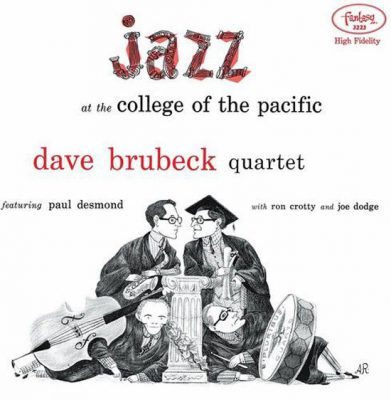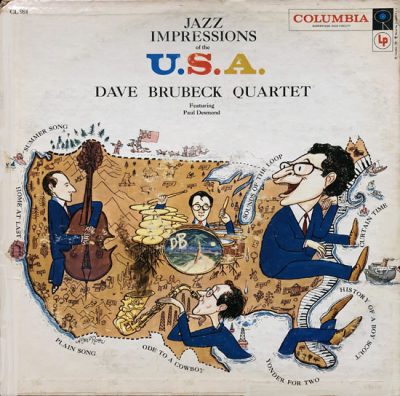.
.
Paul Morris is a graphic designer and writer who collects album art of the 1940’s and 1950’s. He finds his examples of influential mid-century design in the used record stores of Portland, Oregon..
In this edition, Paul writes about jazz album covers that offer glimpses into intriguing corners of the culture of the 1950’s
.
.
__________
.
To commemorate the beginning of this year’s PDX Jazz Festival, I have a couple jazz album covers that offer glimpses into two intriguing corners of 1950’s culture.
First is $64,000 Jazz, a Columbia compilation album released in 1955 as a tie-in with the new CBS game show The $64,000 Question. Readers may have learned something about the game show years from the 1994 film Quiz Show, about an NBC game show that was exposed as rigged.
.

.
.
The photo of three rapt viewers and the TV screen is credited to the eminent Alfred Gescheidt. It’s curious that the video camera rigs are visible at the sides.
.

.
.
The liner notes are by CBS’s jazz specialist George Avakian, who was the expert consultant when the show chose jazz as the category of the week in October 1955. By this time The $64,000 Question was the number-one show on TV. Avakian put together 12 cuts from the Columbia holdings for the album. He wrote in the eternally hopeful manner of the jazz fan wishing for a wave of popularity:
“By the time this album appears it is fairly certain that the country will be talking about jazz as it has never talked about its own music in the sixty-odd years of its existence. This confidence is inspired by the unusual character as well as knowledge possessed by this contestant. But even if the hoped-for tide of interest does not rise to the expected level, it is fitting to celebrate the high-water mark of public interest in jazz with this collection of recordings drawn from the great Columbia jazz catalog.”
The CBS series also was secretly rigged, though in more subtle ways, and it never became as publicly scandalous. The album notes claimed, “Elaborate security measures were taken, because of the vast amount of money involved, to make certain that not even a suspicion of chicanery could enter into the administration of the program.” The top prize would be more than a half million dollars today.
.
.
_____
.
.
The second cover from my collection is a 10-inch LP from 1953 with art by Arnold Roth, an illustrator in New York known for children’s books and magazine work in National Lampoon, Sports Illustrated, the New Yorker, and Playboy. Born in 1929, he was a jazz fan and amateur sax player who illustrated a number of jazz and folk album covers.
.

.
Woody Herman, whose bands were known as herds, is shown on Ridin’ Herd literally riding on a herd of six cattle. Their horns are brass instruments, each one emitting the title of a song.
.

.
This was part of a Columbia series called “House Party,” with the theme of entertaining at home. The description was in trendy lowercase: “music for every mood…for every taste…in this new Columbia series!” The large logo with the sappy photo was placed on all the covers, no matter how it visually clashed with the rest of the design. Other records in the series that could enhance your party were by acts ranging from Jo Stafford, Tony Bennett and Duke Ellington to Frankie Yankovic, Liberace, and the Columbia Military Band.
.
.
_____
.
.
An early live recording by Brubeck, Live at the College of the Pacific, was probably the best-known recording made in Stockton, California. It had this cover with Roth’s drawing of the quartet that featured Paul Desmond.
.

.
.
_____
.
..
One more Roth cover shows a U.S. map with song titles arranged more or less geographically. Why is “Summer Song” in the apparently cold north? The portrait of Desmond is clever, though I don’t get why smoke is rising from his sax.
.

.

.
.
.
.
.
_____
.
.
In Volume 1 of “Cover Stories,” Paul shared his collection of covers by Alex Steinweiss, known as the father of the record album cover, and for many years in charge of Columbia Records’ art department.
Volume 2 focused on Columbia covers
Volume 3 featured jazz illustrations from the early years of the record album
Volume 4 revisited the 1950’s with images of fans holding and enjoying their albums
Volume 5 explored the work of Alex Steinweiss when he used the pseudonym “Piedra Blanca”
Volume 6 featured teenagers of the 1950’s enjoying their music
Volume 7 featured Steinweiss album covers from his prime period — the late 1940’s and early 1950’s
Volume 8 featured a “disturbing” and fascinating trend in 1950?s album art — Records on the Floor!
Volume 9 featured a selection of RCA Victor album covers from Paul’s collection
Volume 10 featured a selection of covers by Curt John Witt, the prolific illustrator for mid-century budget record labels
Volume 11 featured a selection of “glamour girl” covers
Volume 12 featured the “late Columbia” era of master designer Alex Steinweiss
Volume 13 focused on Everest Records, the last of several new labels that Alex Steinweiss helped launch
Volume 14 Paul shares some of his personal jazz record collection, concentrating on the lesser known and sometimes quirky covers that emphasize photographs
Volume 15 took a look at the art of London Records
Volume 16 Paul shared some jazz covers from the 1950’s
Volume 17 looked at the album cover art of Erik Nitsche, a pioneer of modern design
Volume 18 featured album covers picturing designer furniture
Volume 19 showcased choice examples of Decca Records
Volume 20 featured examples of vintage kitsch on several themes
Volume 21 featured samples of Alex Steinweiss album covers, created during the early 1940’s, at the beginning of his career
Volume 22 showcased album covers of Paul’s favorite pop singers of the 1950’s
Volume 23 looks at the art of the classical label Westminster Records
.
.
.
.
.
.
.




























